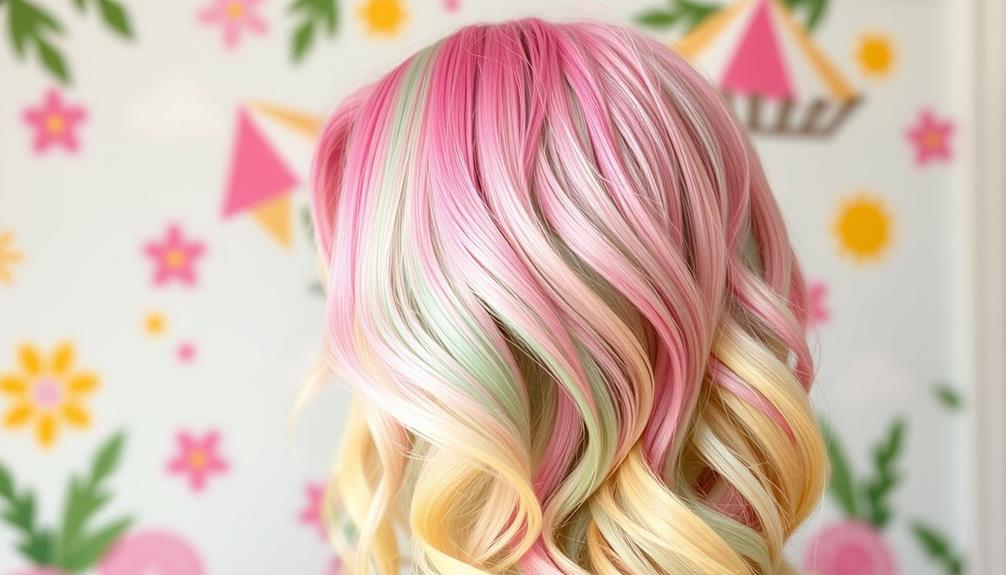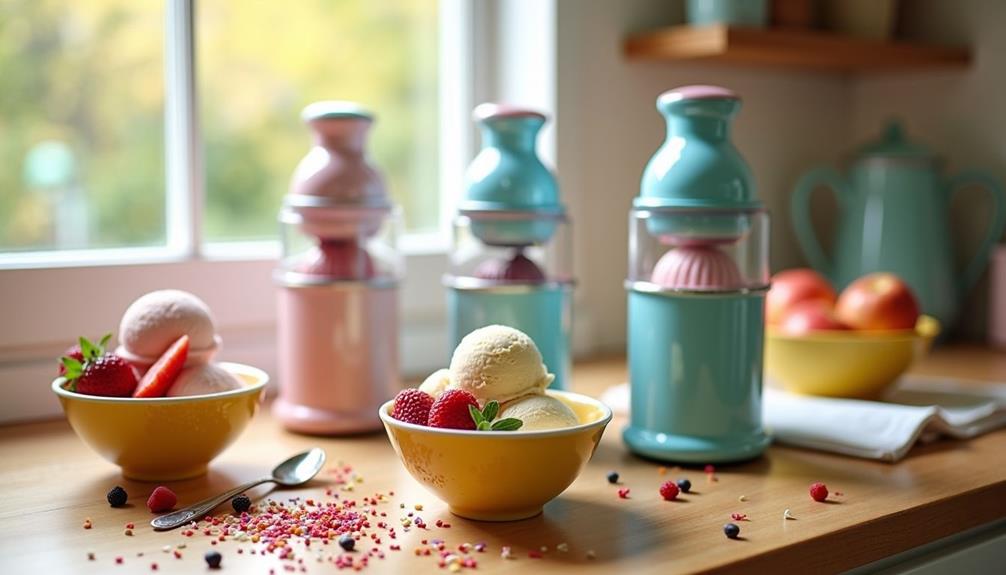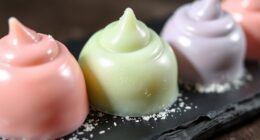The Ice Cream Haircut is a playful and vibrant style that draws inspiration from your favorite sweet treat. Characterized by a rounded, voluminous top and curled ends, this trendy look has taken social media by storm, especially on TikTok. You can express your personality through various pastel shades, making it truly unique. To achieve this eye-catching style, consult a professional stylist and maintain it with regular trims and color-safe products. You'll find plenty of variations, from Neapolitan blends to Cotton Candy hues. If you're curious about tips to perfect this hairstyle, just keep going!
Key Takeaways
- The Ice Cream Haircut features a rounded, voluminous top with outward curled ends, inspired by cartoonish aesthetics and sweet treats.
- Popularized on TikTok, the hashtag #icecreamhair has gained over 46 million views, showcasing its appeal among younger generations.
- Variations like Neapolitan Dream and Rainbow Swirl allow for vibrant, personalized styles that reflect individual creativity and self-expression.
- Regular maintenance, including trims and color-safe products, is essential for preserving the haircut's vibrancy and structure.
- Similar styles like the Shaggy Haircut and Fluffy Hair offer alternative looks while still emphasizing volume and playful aesthetics.
Definition and Origin
The Ice Cream Haircut stands out with its rounded, voluminous top and outward curled ends, giving it a whimsical appearance reminiscent of scoops of ice cream. This hairstyle trend gained traction on TikTok in late 2022, enchanting younger audiences and inspiring a wave of creativity in hairstyling.
You might've come across the hashtag #icecreamhair, which amassed over 46 million views, showcasing countless variations of this playful look. Much like the ever-evolving world of nail styles, this haircut invites trendsetters to explore bold and unique interpretations.
Characterized by its unique silhouette, the Ice Cream Haircut often draws inspiration from cartoonish aesthetics, much like those found in games such as Roblox. This connection resonates with those who enjoy unconventional hairstyles that break free from traditional norms.
Tailoring the style with pastel colors, reminiscent of your favorite ice cream flavors, adds to the charm and individuality of this haircut.
The Ice Cream Haircut challenges conventional hairstyling, encouraging self-expression and experimentation. Its rounded top and voluminous shape invite you to embrace a fun, lighthearted approach to your hair.
If you're ready to stand out, this hairstyle could be the perfect way to showcase your playful personality.
Popularity and Trends

Countless hairstylists and social media users have embraced the Ice Cream Haircut, making it a standout trend among younger generations. This style skyrocketed on TikTok around late 2022, with the hashtag #icecreamhair racking up over 46 million views. Its vibrant colors and playful shapes have captivated young audiences, especially young Caucasian boys, who often compare it to the Shaggy haircut seen in Roblox.
This bold trend reflects the growing interest in self-care and personal grooming, similar to Justin Silva Jr's DIY grooming tips, empowering individuals to express themselves through unique hairstyles.
The Ice Cream Haircut encourages creativity and self-expression, allowing you to experiment with different hairstyles that mimic your favorite ice cream flavors. As you scroll through popular videos, you'll see countless users showcasing their unique takes on this fun trend, reinforcing its appeal and engagement.
The hairstyle has also inspired memes and humorous content on social media, further solidifying its status as a modern pop culture phenomenon.
Achieving the Ice Cream Haircut

Achieving your perfect Ice Cream Haircut starts with ensuring your hair is at least four inches long, ideally with a thicker, straighter texture for that desired volume and shape.
To get started, consult a professional stylist who can help you create the look you envision. It's important to take into account regular trims to maintain healthy hair as well, especially if you want layered bangs for added dimension. Bring reference photos to communicate your desired style.
Next, prepare your hair by washing it with a sulfate-free shampoo and moisturizing conditioner. Towel-dry it slightly, then blow-dry using a round brush to create upward volume and flipped ends, giving your haircut that signature bounce.
Once your hair is dry, use volumizing hairspray to maintain lift and texture. Remember to spray from underneath to prevent weighing your style down.
Regular maintenance is key to keeping your Ice Cream Haircut looking fresh and vibrant. Schedule monthly root touch-ups and use color-safe products to preserve those vibrant hues.
Style Variations

Often, style variations of the Ice Cream Haircut allow you to express your individuality while embracing playful colors and textures. Each creative hairstyle reflects different flavors, giving you plenty of options to showcase your personality. If you’re feeling bold, you can even opt for a vivid “ice cream cut” with swirls of vibrant colors inspired by your favorite frozen treats. The versatility of the ice cream cut allows you to experiment with different looks and find the perfect style that screams “you.” Whether you prefer a subtle pastel hue or a more daring rainbow design, the options are endless with the ice cream cut. If you’re feeling adventurous, you can take inspiration from sweet ice cream drawing ideas and incorporate them into your hair design for a fun and unique look. From classic cone patterns to intricate sundae details, there are endless possibilities to bring the essence of a delicious frozen treat to life in your hair. With the ice cream cut, you have the freedom to unleash your creativity and turn heads with a hairstyle that is as sweet and playful as you are.
| Style Name | Description |
|---|---|
| Neapolitan Dream | Combines chocolate brown, strawberry pink, and vanilla blonde hues, featuring medium to long layers for an eye-catching look. |
| Rainbow Swirl | Blends vibrant, bright colors using layering and texturizing techniques, creating a whimsical appearance reminiscent of an ice cream parlor. |
| Mint Chocolate Chip | Mixes invigorating mint green shades with rich chocolate tones, balancing playful colors with sophistication. |
| Cotton Candy Fantasy | Showcases pastel pinks, blues, and purples, evoking a dreamy aesthetic that captures the essence of fluffy cotton candy. |
These variations emphasize vibrant colors and self-expression, allowing you to tailor your Ice Cream Haircut to your unique taste. Whether you prefer the classic Neapolitan Dream or the whimsical Rainbow Swirl, each style offers a chance to experiment and have fun with your look. Embrace the boldness of these styles and let your creativity shine!
Maintenance Tips

Embracing the vibrant styles of the Ice Cream Haircut means you'll want to keep your look fresh and colorful. Just like ensuring your dog's health and well-being, maintaining those stunning vibrant shades requires a bit of effort, but it's worth it!
Here are some essential maintenance tips to help you shine.
- Use color-safe shampoos and conditioners to prevent fading and enhance vibrancy.
- Wash your hair with cool water to minimize damage and retain your color longer.
- Schedule regular trims every 6-8 weeks to maintain that layered look and prevent split ends.
Limiting the use of heat styling tools is vital too, as it helps protect your hair health and prevent frizz. If you must use them, always apply a heat protectant beforehand.
Additionally, don't forget about monthly root touch-ups to keep your colors looking fresh and fabulous. For further inspiration, consider the importance of regular grooming when caring for your furry friends!
Similar Haircuts

If you love the playful vibe of the Ice Cream Haircut, you'll find several similar styles that capture that same spirit. The Bowl Cut features a rounded top like the Ice Cream Haircut, but it lacks the flipped edges, offering a more subdued look.
For a messier, layered appearance, the Shaggy Haircut is perfect; it shares the voluminous aesthetic that makes the Ice Cream Haircut so enticing. You can even incorporate different colors and textures into these styles, much like the neutral color palettes that are trending in modern farmhouse decor.
If you want to embrace a bouncy, textured look, consider Fluffy Hair. This style emphasizes volume and texture while presenting a playful and whimsical style, much like the Ice Cream Haircut.
Another fun option is Swirled Hair, which mimics soft-serve ice cream using unique styling techniques for an engaging aesthetic.
Each of these haircuts can easily be customized with various colors and textures, allowing for individual expression that aligns perfectly with the Ice Cream Hair trend.
Whether you opt for a shaggy finish or a fluffy style, you're sure to stand out with these bold and creative cuts that celebrate your unique personality.
Frequently Asked Questions
What Is an Ice Cream Hair Cut?
An Ice Cream Haircut's a fun, voluminous style featuring a rounded top and outward-flipping edges. It's playful, encourages self-expression, and is especially popular among young boys looking to stand out with their hair.
How to Get Fluffy Ice Cream Hair?
Picture your hair as a soft, airy cloud. To achieve fluffy ice cream hair, wash, blow-dry with a round brush, add layered bangs, and finish with volumizing spray. Regular trims keep it vibrant and fresh!
Conclusion
In a world where hairstyles can be as sweet as your favorite dessert, the ice cream haircut is your ticket to standing out. Embracing vibrant colors and playful layers, it's the perfect way to express your personality. So, why not ditch the old bowl cut and give your hair the scoop it deserves? With a little creativity and some styling finesse, you'll be turning heads like it's 1985 at the local roller rink!










